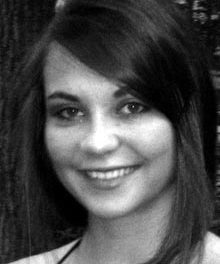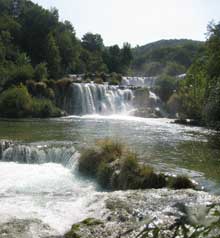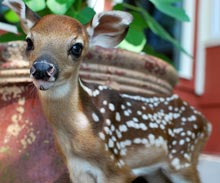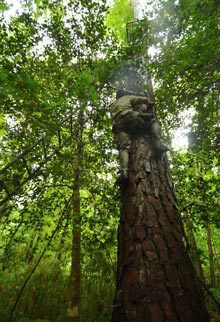
Four locals eager for hunting season reveal the differences among deer hunters. 
One hunts deer with a bow and arrow high in the camouflage of a tree. One is a sheriff deputy and taxidermist who hunts by rifle with his three daughters. One hunts in fellowship as the president of a hunting club. One is a local good ‘ol boy who hunts a country road by foot with a keen eye and lives off his land. These huntsmen may have different styles, but all of them cultivated a devout passion for hunting as young boys. All of them have been waiting for August 15, the first day of hunting season, in great anticipation.
It’s raining lightly in the woods an hour west of Beaufort in Martin, S.C. where Carl Brown, the bow hunter, is setting up his deer stand and hunting camera two weeks prior to opening day. With the steel stand thrown over his shoulder he makes his way through the lush forest to find the tree he will hunt from this season. I follow him, stepping in his footsteps and observing the way he decodes the wildlife of the land. He points out the signs to my untrained eye—subtle deer trails, year-old antler rubs on sapling trees, hoof imprints in the wet, black earth, broken roots and mud stains from hogs, acorns the deer will eat. He crouches down by a fallen tree and pulls a single deer hair from the bark. I have never been as tuned in to a forest as the hunter before me.
In South Carolina where there is no limit to the number of deer an individual can kill nor restrictions  on weaponry, Carl still chooses the bow and arrow because of its intimacy. Unlike the rifle hunter who can shoot a deer from 100 or 200 yards, Carl can only be about 30 yards from a deer to release his arrow with confidence. “With a bow that deer is within range of hearing your boot scrape on the stand; it’s within range of hearing a click of a safety on a gun. They can smell like a hound dog. Everything’s got to be perfect,” he tells me. A rifle is no match to Carl’s bow when it comes to his approach: “I’ll be back in the woods right next to where they sleep and they’ll come to me before anyone else.”
on weaponry, Carl still chooses the bow and arrow because of its intimacy. Unlike the rifle hunter who can shoot a deer from 100 or 200 yards, Carl can only be about 30 yards from a deer to release his arrow with confidence. “With a bow that deer is within range of hearing your boot scrape on the stand; it’s within range of hearing a click of a safety on a gun. They can smell like a hound dog. Everything’s got to be perfect,” he tells me. A rifle is no match to Carl’s bow when it comes to his approach: “I’ll be back in the woods right next to where they sleep and they’ll come to me before anyone else.”
However, most hunters, like sheriff deputy Tom Vido, practice long distance precision with a rifle. Tom also hunts deer tracking clues left behind in the wild. “I’ll actually walk the woods and look for certain indicators, like a buck will make a rub on a tree to get the velvet off his antlers and mark his territory for another buck to see or smell it. Then I’ll look for what they call a scrape. The buck will actually clear out a space on the ground and he’ll urinate in it to entice a doe to do the same, and when the doe urinates in this scrape he’ll trail her to mate.”
Deer pattern also revolves around the moon and hour of day. Deer activity appears more pronounced at dawn and dusk when there is a quarter or three-quarter moon. Their four-chambered stomachs are designed to feed rhythmically in order to digest woody fibers and food high in cellulose; and their eyes are built with more light-detecting cells than humans’ so they can feed during these low-light situations, thus avoiding predators.
For the most part, being in touch with nature is what drives these huntsmen to spend countless hours in the woods waiting for a buck to walk by. “It’s not just about the harvesting of the animal, because a lot of times you don’t even pull the trigger. It’s more about seeing them out in nature and watching them walk through the woods in their natural habitat,” says Tom.
 Tom was also a former game warden for the Department of Natural Resources and has since made taxidermy a hobby. “I have three daughters and they all hunt, and if you let one mount one item then the other two are going to want them,” Tom says. So he ordered a $49 DVD and taught himself the art of stuffing the skins of animals and mounting them in lifelike form. Now Tom has clients sending him frozen animals from Montana simply by word of mouth. “I think the most fun thing about it is actually trying to make that animal, that creature, that bird, whatever it is, come back to life.”
Tom was also a former game warden for the Department of Natural Resources and has since made taxidermy a hobby. “I have three daughters and they all hunt, and if you let one mount one item then the other two are going to want them,” Tom says. So he ordered a $49 DVD and taught himself the art of stuffing the skins of animals and mounting them in lifelike form. Now Tom has clients sending him frozen animals from Montana simply by word of mouth. “I think the most fun thing about it is actually trying to make that animal, that creature, that bird, whatever it is, come back to life.”
Of course aside from meditating on nature, there is an experience of adrenaline when a great buck crosses the path of a true hunter who has been diligently waiting for weeks or months to execute his or her weapon. For some hunters, this experience is comparable to seeing a beautiful woman. “If I see a woman and she takes my breath away it’s like seeing a big buck,” says Trevor Wester, experienced hunter born and raised in Beaufort.
Or, according to Bill Stanley who has been the president of Tarboro Hunting Club for seven years and a member for 35, this rush is called “buck fever”: “No matter how old you are and how many years you’ve hunted, if you see a real nice trophy buck walk out you get something called buck fever. That’s when the adrenaline gets to flowin’, sometimes your knees get to knockin’, and sometimes you can’t hold a gun straight. You have to take a lot of deep breaths and settle down to make the shot.”
The benefits of a hunting club include shared community deer stands that are set up pre-season, food plot resources, the shared cost of leasing the property, a clubhouse for cookouts and—what Bill particularly enjoys—the camaraderie. Also in a private club, equal opportunities at deer are shared: “If one person is having a tremendous amount of success in one area we go by a respect rule to let someone else have an opportunity in that area,” says Bill.
Like all these huntsmen whose inborn fire for hunting was passed on by their fathers, stepfathers and granddaddies, recruiting new and young hunters is a priority of Bill’s club. “If we don’t teach our children the way we were taught, we’d be a dying race.”
Here in the sweet smelling rain the forest seems to come to life, louder and more vibrant than before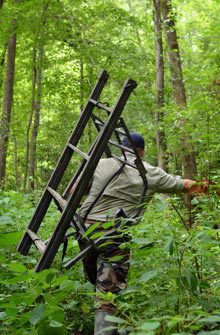 . Carl assembles his deer stand, props it up and scales the tree to secure it. Next he tosses the ears of corn he’s harvested in the surrounding area, forming a yellow brick trail to stop the deer more so than to lure them.
. Carl assembles his deer stand, props it up and scales the tree to secure it. Next he tosses the ears of corn he’s harvested in the surrounding area, forming a yellow brick trail to stop the deer more so than to lure them.
Finally he mounts a motion-sensitive hunting camera to a tree, which will photograph all the deer that enter his hunting space. “I have mixed feelings about the camera. I love it because it allows me to pick a deer. I want to shoot the oldest, most mature, biggest buck I can. At the same time, I remember as a little kid always expecting to see some giant, massive rack, world record deer. That was kind of like the magic of hunting—you never knew what you were going to see. In a way it’s like the game cameras have stolen that mystery; they’ve stolen the magic out of that little boy’s dream.”
These four men are true huntsmen for a reason, although their opinions and practices vary. “Attention to detail, first and foremost. Second, positive thinking. Third, and most important, experience,” Trevor knows what it takes. And yet, even good ol’ boys like Trevor who tell me, “yeah, we whack deer,” also admit “shootin’ them isn’t the fun. Seeing a deer and waiting two weeks, three weeks, four week or six months to get a shot at him—that’s the fun.
There is a difference between killing a deer and hunting, Carl teaches me. “I refuse to take anyone out so that they can kill something. You want to learn how to hunt, you want to be a hunter, you want to respect it and earn being able to take that animal, I’ll take anybody. I will teach them absolutely everything I know.”
It’s about deer quality management. It’s about improving the quality of the hunting experience by balancing the deer herd, taking an even ratio of doe and buck, and letting the younger buck pass by in order to kill the most mature.
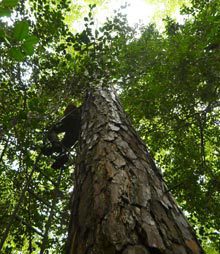 “Someone who harvests only what they need is a true hunter,” says Tom. “They don’t waste it. There is a difference between a true sportsmen and a responsible hunter and somebody that just goes out because they can buy a license to kill.”
“Someone who harvests only what they need is a true hunter,” says Tom. “They don’t waste it. There is a difference between a true sportsmen and a responsible hunter and somebody that just goes out because they can buy a license to kill.”
And as told by Bill, “Being respectful of the wildlife, being safe, being respectful of the resources you have as well as the property that you have to hunt on makes you a good hunter. I don’t think it’s nothing about what size deer or how many you shoot that makes you a better hunter or lesser hunter than anybody else.”
Whether by rifle or bow, by tree stand or dogs, for the love of nature and the challenge, let the hunting games begin.

